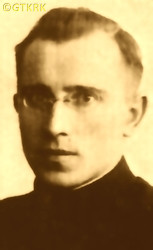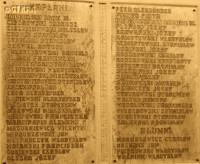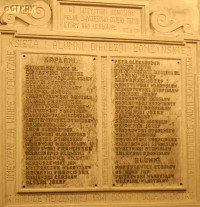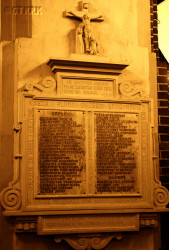Roman Catholic
St Sigismund parish
05-507 Słomczyn
85 Wiślana Str.
Konstancin deanery
Warsaw archdiocese, Poland
full list:
displayClick to display full list

searchClick to search full list by categories
wyświetlKliknij by wyświetlić pełną listę po polsku

szukajKliknij by przeszukać listę wg kategorii po polsku

Martyrology of the clergy — Poland
XX century (1914 – 1989)
personal data
surname
SZULC
forename(s)
Joseph (pl. Józef)
function
diocesan priest
creed
Latin (Roman Catholic) Church RCmore on
en.wikipedia.org
[access: 2014.09.21]
diocese / province
Łomża diocesemore on
www.kuria.lomza.pl
[access: 2012.11.23]
RC Military Ordinariate of Polandmore on
en.wikipedia.org
[access: 2014.12.20]
date and place
of death
15.07.1943

Jeziorkotoday: Piątnica gm., Łomża pov., Podlaskie voiv., Poland
more on
en.wikipedia.org
[access: 2022.01.28]
details of death
After German and Russian invasion of Poland in 09.1939 and start of the World War II, after the start of the Russian occupation — Łomża was occupied by the Germans on 09.09.1939, but already on 22.09.1939 they handed the town over, in accordance with Ribbentrop–Molotov pact, to the Russians — first, the property of the Seminary was seized by the Germans, and then closed by Russians, continued his studies clandestinely.
Ordained after the German attack on 22.06.1941 on their erstwhile ally, the Russians, and the beginning of the German occupation.
Became chaplain of the resistance Home Army AK (part of Polish Clandestine State).
Arrested by the Germans on .07.1943 in the hospital in Łomża, where was undergoing treatment — that day intended to take the train to his family Łapy to visit his father, but missed the train, so returned to the hospital.
Waiting to be admitted to prison — as a witness to the events remembered — „was holding a little book in his hand. When asked if it was a prayer book, replied: «No. These are my poems» […] Had black, openwork gloves on his hands. Maybe had sore hands, because it wasn't cold. Was very nervous and weak after the illness […] A moment after the last prisoner was brought into the room, a senior officer entered with a whip in his hand, accompanied by gendarmes with a dog. Starting from the left, stopped, asked for a name and after hearing the answer, issued a short order: 'Rauss!' Those indicated stood up and calmly left the room. There was silence, only the dog barked sometimes, but it did not attack anyone”. Around 11:00 a.m., a „car with armed gendarmes and a machine gun on the roof of the cab drove out of the prison gate. Behind it drove a truck covered with a tarpaulin and at the end another car with gendarmes. In the cracks in the tarpaulin people gathered in front of the prison noticed some of the arrested. The convoy headed towards Piątnica…”.
The same day murdered in a mass execution of 52 „hostages” — part of German extermination plan of Polish intelligentsia of Białystok region, called «Black July» 1943 — from Łomża intelligentsia. The condemned were placed over the edge of the pit and shot dead with machine gun bursts.
That same day, 15.07.1943, a German announcement appeared on the streets of Białystok, stating: „Recently, bandit attacks on Germans from the Reich and the local population have been increasing in the Białystok District [...] In retaliation for the above and in order to achieve peace in the Białystok District, the following countermeasures were carried out: [...] 1,000 people from the Łomża district suspected of banditry or belonging to the resistance movement were shot, their property was confiscated, and their houses were destroyed [...] In addition, in all district towns, 19 people from the medical, legal, municipal and teaching communities, together with their families, were arrested and shot, because they were supporters or participants in the Polish resistance movement [...] Further attacks on Germans from the Reich and the local population will entail even more severe measures, especially against the ideological leaders of the resistance movement”.
The poems were lost.
cause of death
mass murder
perpetrators
Germans
sites and events
«Black July» 1943Click to display the description, Collective responsibility („Hostages”)Click to display the description, Ribbentrop‐MolotovClick to display the description, Pius XI's encyclicalsClick to display the description
date and place
of birth
23.01.1915

Łapytoday: Łapy gm., Białystok pov., Podlaskie voiv., Poland
more on
en.wikipedia.org
[access: 2022.01.28]
presbyter (holy orders)
ordination
21.09.1941

positions held
till c. 1943
vicar — Dobrzyjałowotoday: Pątnica gm., Łomża pov., Podlaskie voiv., Poland
more on
en.wikipedia.org
[access: 2022.07.16] ⋄ St Stanislav the Bishop and Martyr RC parish ⋄ Jedwabnetoday: Jedwabne gm., Łomża pov., Podlaskie voiv., Poland
more on
en.wikipedia.org
[access: 2022.05.23] RC deanery
vicar — Tykocintoday: Tykocin gm., Białystok pov., Podlaskie voiv., Poland
more on
en.wikipedia.org
[access: 2021.12.18] ⋄ Holy Trinity RC parish ⋄ Sokołytoday: Sokoły gm., Wysokie Mazowieckie pov., Podlaskie voiv., Poland
more on
en.wikipedia.org
[access: 2021.08.06] RC deanery
till 1939
student — Łomżatoday: Łomża city pov., Podlaskie voiv., Poland
more on
en.wikipedia.org
[access: 2022.01.28] ⋄ philosophy and theology, Theological Seminary — till the closing of the Seminary by the Russians, later continued his studies clandestinely
others related
in death
BESZTA–BOROWSKIClick to display biography Anthony, BURAKClick to display biography Mark, KLIMCZAKClick to display biography Michael Eugene (Fr Dennis), KOCHANOWSKIClick to display biography Felix, KOZŁOWSKIClick to display biography Joseph, KUŹMICKIClick to display biography Witold, OLSZEWSKIClick to display biography Louis, OPIATOWSKIClick to display biography Henry, PĘZAClick to display biography Alexander, PŁOŃSKIClick to display biography Joseph, ROSZAKClick to display biography Edmund, RUTKOWSKIClick to display biography Bronislav, SKOKOWSKIClick to display biography Justin, SZYPIŁŁOClick to display biography Casimir
sites and events
descriptions
«Black July» 1943: On 20.05.1943 East Prussia German Germ. Gauleiter (Eng. regional leader), Erich Koch, nominated Otton Helwig a new German commander of SS und Polizeiführer (Eng. SS and police commander) of Bezirk (Eng. region) Białystok. He immediately initiated a pacification action ostensibly targeted at Polish partisans. The real aim was intimidation of the Poles from Białystok region and extermination of its leading classes. Herbert Zimmermann, security police and SD commanded, deputy commander of Einsatzgruppen SS (Eng. Operational Groups) for Germ. Bezirk (district) Bialystok, issued an order to arrest and execute 19 people, physicians, barristers, city staff and teacher, including their families, in each all county cities of the district. On 10.07.1943 a „Commando Müller” (from the surname of its murderous commander, prob. Hermann Müller), consisting of Belarus support batallion, Lithuanian units dressed in German uniforms, German Gendarmerie and police and German Gestapo members, perpetrated a series of mass murders in various places in Bezirk Białystok (including its Łomża and Grodno regions). In 07.1943 Germans murdered more than 1,000 people (prob. near 2,000). On 15.07.1943 only in all county seats of Bezirk Bialystok at least 9 local Polish intelligentsia families, including women, children and old were selected and murdered. Among the victims were many priests: in executions in Pilice forest, Wiszownik forest, Kosówka forest, Navumavichy, Jeziorka, etc. Germans murdered at least 15 clerics. (more on: www.swzygmunt.knc.plClick to attempt to display webpage
[access: 2019.10.13])
Collective responsibility („Hostages”): A criminal practice implemented by the Germans in the occupied territories of Poland, applied from the very first day of World War II. At its core was an appointment and public announcement of a list of names of selected people whose lives depended on absolute compliance with German orders. Any violation of these ordinances, by any person, regardless of the circumstances, resulted in the murder of the designated „hostages”. In the first days of the war and occupation, it was used i.a. by the German Wehrmacht army to prevent acts of continuation of the defense by the Poles. Later, especially in the German‐run General Governorate, it was part of the official policy of the occupation authorities — collective responsibility for any acts of resistance to the occupier's practices. For the life of one German, even if death was due to customary reasons, the Germans carried out executions from a dozen to even a hundred Poles previously designated as „hostages”.
Ribbentrop‐Molotov: Genocidal Russian‐German alliance pact between Russian leader Joseph Stalin and German leader Adolf Hitler signed on 23.08.1939 in Moscow by respective foreign ministers, Mr. Vyacheslav Molotov for Russia and Joachim von Ribbentrop for Germany. The pact sanctioned and was the direct cause of joint Russian and German invasion of Poland and the outbreak of the World War II in 09.1939. In a political sense, the pact was an attempt to restore the status quo ante before 1914, with one exception, namely the „commercial” exchange of the so‐called „Kingdom of Poland”, which in 1914 was part of the Russian Empire, fore Eastern Galicia (today's western Ukraine), in 1914 belonging to the Austro‐Hungarian Empire. Galicia, including Lviv, was to be taken over by the Russians, the „Kingdom of Poland” — under the name of the General Governorate — Germany. The resultant „war was one of the greatest calamities and dramas of humanity in history, for two atheistic and anti‐Christian ideologies — national and international socialism — rejected God and His fifth Decalogue commandment: Thou shall not kill!” (Abp Stanislav Gądecki, 01.09.2019). The decisions taken — backed up by the betrayal of the formal allies of Poland, France and Germany, which on 12.09.1939, at a joint conference in Abbeville, decided not to provide aid to attacked Poland and not to take military action against Germany (a clear breach of treaty obligations with Poland) — were on 28.09.1939 slightly altered and made more precise when a treaty on „German‐Russian boundaries and friendship” was agreed by the same murderous signatories. One of its findings was establishment of spheres of influence in Central and Eastern Europe and in consequence IV partition of Poland. In one of its secret annexes agreed, that: „the Signatories will not tolerate on its respective territories any Polish propaganda that affects the territory of the other Side. On their respective territories they will suppress all such propaganda and inform each other of the measures taken to accomplish it”. The agreements resulted in a series of meeting between two genocidal organization representing both sides — German Gestapo and Russian NKVD when coordination of efforts to exterminate Polish intelligentsia and Polish leading classes (in Germany called «Intelligenzaktion», in Russia took the form of Katyń massacres) where discussed. Resulted in deaths of hundreds of thousands of Polish intelligentsia, including thousands of priests presented here, and tens of millions of ordinary people,. The results of this Russian‐German pact lasted till 1989 and are still in evidence even today. (more on: en.wikipedia.orgClick to attempt to display webpage
[access: 2015.09.30])
Pius XI's encyclicals: Facing the creation of two totalitarian systems in Europe, which seemed to compete with each other, though there were more similarities than contradictions between them, Pope Pius XI issued in 03.1937 (within 5 days) two encyclicals. In the „Mit brennender Sorge” (Eng. „With Burning Concern”) published on 14.03.1938, condemned the national socialism prevailing in Germany. The Pope wrote: „Whoever, following the old Germanic‐pre‐Christian beliefs, puts various impersonal fate in the place of a personal God, denies the wisdom of God and Providence […], whoever exalts earthly values: race or nation, or state, or state system, representatives of state power or other fundamental values of human society, […] and makes them the highest standard of all values, including religious ones, and idolizes them, this one […] is far from true faith in God and from a worldview corresponding to such faith”. On 19.03.1937, published „Divini Redemptoris” (Eng. „Divine Redeemer”), in which criticized Russian communism, dialectical materialism and the class struggle theory. The Pope wrote: „Communism deprives man of freedom, and therefore the spiritual basis of all life norms. It deprives the human person of all his dignity and any moral support with which he could resist the onslaught of blind passions […] This is the new gospel that Bolshevik and godless communism preaches as a message of salvation and redemption of humanity”… Pius XI demanded that the established human law be subjected to the natural law of God , recommended the implementation of the ideal of a Christian state and society, and called on Catholics to resist. Two years later, National Socialist Germany and Communist Russia came together and started World War II. (more on: www.vatican.vaClick to attempt to display webpage
[access: 2023.05.28], www.vatican.vaClick to attempt to display webpage
[access: 2023.05.28])
sources
personal:
historialomzy.plClick to attempt to display webpage
[access: 2013.06.23], historialomzy.plClick to attempt to display webpage
[access: 2024.12.13], pl.wikipedia.orgClick to attempt to display webpage
[access: 2013.06.23]
original images:
historialomzy.plClick to attempt to display webpage
[access: 2024.12.13], historialomzy.plClick to attempt to display webpage
[access: 2013.06.23]
LETTER to CUSTODIAN/ADMINISTRATOR
If you have an Email client on your communicator/computer — such as Mozilla Thunderbird, Windows Mail or Microsoft Outlook, described at WikipediaPatrz:
en.wikipedia.org, among others — try the link below, please:
LETTER to CUSTODIAN/ADMINISTRATORClick and try to call your own Email client
If however you do not run such a client or the above link is not active please send an email to the Custodian/Administrator using your account — in your customary email/correspondence engine — at the following address:

giving the following as the subject:
MARTYROLOGY: SZULC Joseph
To return to the biography press below:
 Click to return to biography
Click to return to biography












